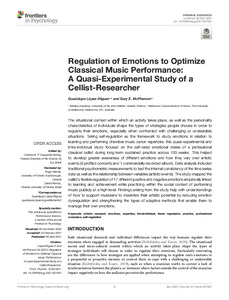Regulation of Emotions to Optimize Classical Music Performance : A Quasi-Experimental Study of a Cellist-Researcher
López-Íñiguez, Guadalupe; McPherson, Gary E. (2021)
Avaa tiedosto
Lataukset:
López-Íñiguez, Guadalupe
McPherson, Gary E.
Frontiers
2021
1664-1078
López-Íñiguez G.,& McPherson GE (2021). Regulation of Emotions to Optimize Classical Music Performance: A Quasi-Experimental Study of a Cellist-Researcher. Frontiers in Psychology, 12, 627601. doi: 10.3389/fpsyg.2021.627601
lehtiartikkeli
Julkaisun pysyvä osoite on
https://urn.fi/URN:NBN:fi-fe2021072241657
https://urn.fi/URN:NBN:fi-fe2021072241657
Tiivistelmä
The situational context within which an activity takes place, as well as the personality characteristics of individuals shape the types of strategies people choose in order to regulate their emotions, especially when confronted with challenging or undesirable situations. Taking self-regulation as the framework to study emotions in relation to learning and performing chamber music canon repertoire, this quasi-experimental and intra-individual study focused on the self-rated emotional states of a professional classical cellist during long-term sustained practice across 100-weeks. This helped to develop greater awareness of different emotions and how they vary over artistic events (9 profiled concerts and 1 commercially recorded album). Data analysis included traditional psychometric measurements to test the internal consistency of the time series data as well as the relationship between variables (artistic events). The study mapped the cellist’s flexible regulation of 17 different positive and negative emotions empirically linked to learning and achievement while practicing within the social context of performing music publicly at a high level. Findings arising from the study help with understandings of how to support musicians to maximize their artistic potential by reducing emotion dysregulation and strengthening the types of adaptive methods that enable them to manage their own emotions.
